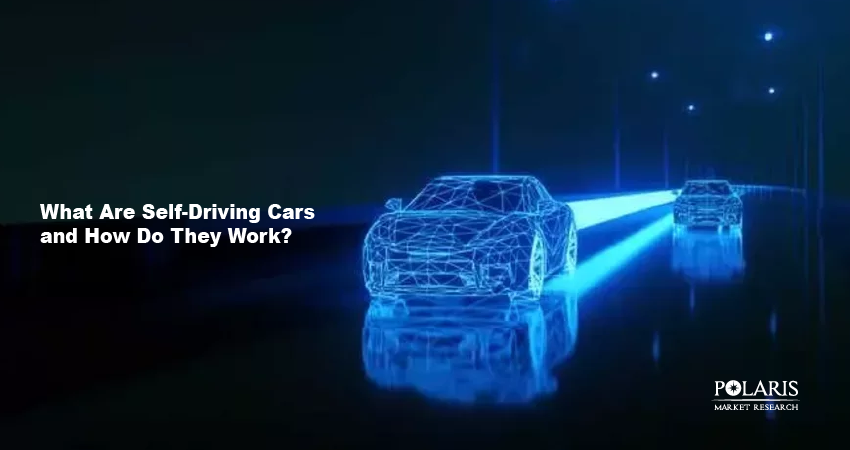What Are Self-Driving Cars and How Do They Work

Cars are a major mode of transportation in the modern world. They have been around for well over a century. Throughout the period, cars have witnessed significant evolution. Today, cars feature several advanced technologies that enhance driver and passenger safety. These features also improve the overall driving experience.
Cars that can drive themselves have become increasingly popular over the past few years. In this blog post, we explain to you what self-driving cars actually are. We cover the various technologies that enable autonomous driving in these vehicles. The market's primary growth drivers and key metrics for self-driving cars have also been described. Let's get started!
Self-Driving Cars: Introduction
A self-driving car is defined as an autonomous vehicle that can sense its environment and operate without the involvement of a human. A fully autonomous car doesn’t require a human passenger to take control at any time. It also doesn’t need the presence of a human passenger inside it. A self-driving car can go to all places that are accessible to a traditional car. Also, it's capable of doing everything a human driver can do.
Self-Driving Cars Market Metrics
We’ve done a detailed analysis of the self-driving cars market. Our analysis reveals that the market for self-driving cars was valued at USD 30.04 billion in 2024. It is projected to account for a CAGR of 14.2% during the projection period.
Technological advancements and the growing adoption of artificial intelligence are the key factors driving the adoption of self-driving cars. The self-driving cars market is also experiencing an increasing number of strategic initiatives, such as mergers and collaborations.
Autonomy Levels in Self-Driving Cars
Self-driving technology is still in its development stages. However, it’s becoming increasingly common and has the potential to change how we go from one place to another. In the automotive market, the various levels of autonomy in self-driving cars are:
Level 0: All the major systems in level 0 self-driving cars are controlled by humans.
Level 1: Certain systems in these cars can be controlled by the vehicle. These systems typically include automatic braking and cruise control.
Level 2: Level 2 self-driving cars have at least two simulated automated functions. These features include steering and acceleration. These cars do require humans for safe operations.
Level 3: These cars are capable of managing safety functions under certain conditions. However, the driver is expected to take control of the vehicle when alerted.
Level 4: Level cars are fully autonomous cars in some driving scenarios.
Level 5: The car is fully autonomous in all situations.
Technologies that Enable Self-Driving
Self-driving cars need to be able to perceive their surroundings to operate safely. They must sense the objects, vehicles, humans, road conditions, and everything else that a human driver would take into account when driving. But how are self-driving cars able to replace human vision? Well, they do it by using three key image and sensor technologies. These include:
Radar
Products from the automotive radar market have been used in cars for a while now. It typically informs automatic emergency braking and adaptive cruise control in cars. Radar makes use of radio waves that are reflected back from distant surfaces. The technology can perceive objects that are several hundred yards in distance. It can also determine their size and speed.
Lidar
Lidar makes use of laser light pulses for scanning the environment. The technology sends millions of laser signals every second. The reflected signals from surfaces are detected by the receiver. The information is then used to create a 3D environment of the vehicle’s surroundings.
Working of Self-Driving Cars Explained
The self-driving cars market is made possible by artificial intelligence technologies. Developers of self-driving cars make use of massive volumes of data from image recognition systems. Machine learning systems and neural networks are also used for building systems that can drive autonomously.
Patterns are identified in data with the use of neural networks. These patterns are then fed into machine learning algorithms. The data is obtained from various sensors. These include radar, lidar, and remote sensing methods. Neural networks use the data to learn to identify the elements of a given driving environment.
A map of the environment is developed by the self-driving car for understanding its environment and planning its path. The car must determine a route to the destination that’s safe and fast. The car also needs to follow traffic rules and implement obstacle avoidance. Self-driving cars also make use of geofencing. Geofencing enables the navigation of the self-driving vehicle within pre-defined boundaries.
Self-driving cars make use of the Global Positioning System (GPS) or another location-based technology for creating virtual boundaries around specific geographic areas. Automated actions or alerts are triggered when the vehicle exits or enters a defined area.
Benefits of Self-Driving Cars
Self-driving cars have several benefits to offer. These cars promise improved convenience and can also improve the quality of life for many individuals. Older adults and individuals who are physically disabled can maintain their independence. These cars can be used for sending items that one has forgotten.
The real promise of these vehicles lies in their promise to reduce carbon dioxide emissions. The autonomous driving capabilities mean these vehicles can find the most optimal routes and reduce traffic congestion. Self-driving cars can also help cut down on transportation costs. These cars can improve walkability and free up parking lots for other uses.
To Conclude
Cars are an important means of travelling today. And the introduction of self-driving cars is taking the capabilities of these vehicles to a whole new level. Sure, the technology for fully autonomous driving cars is still developing. However, it’s advancing at a rapid pace. As technology matures, the self-driving cars market demand is expected to grow in the years to come.

